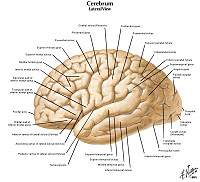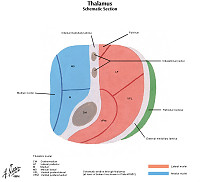|
Website Cases
Additional case (NOT assigned):
CASE NUMBER 544
This case follows the clinical course of a patient who presents with cognitive decline. Use the image gallery below to follow the case.
Image Gallery:
After reviewing the case on your own, click here to see a debrief video prepared by Dr. Johnson to discuss the clinical components of this case.
--Click here to progress to part 2 of the case in which the clinical and pathology findings are discusssed--
CASE NUMBER 543
This case follows the clinical course of a patient who presents with a progressive movement disorder. Use the image gallery below to follow the case.
Image Gallery:
After reviewing the case on your own, click here to see a debrief video prepared by Dr. Mantri to discuss the clinical components of this case.
--Click here to progress to part 2 of the case in which the clinical and pathology findings are discussed--
CASE NUMBER 301
This case follows the clinical course of a patient who presents with altered mental status. Use the image gallery below to follow the case.
Image Gallery:
The gross findings in viral encephalitis may be underwhelming. The intact brain may show hyperemia (as seen here) due to vascular congestion and edema. Fixed and cut specimens may show punctate hemorrhages in the white matter.
|
Acute and subacute encephalitis are characterized by meningeal and perivascular inflammatory infiltrates that are predominantly T cells. In addition, “microglial nodules” composed of small, tight clusters of activated microglia may be seen around dying neurons.
|
|
--After reviewing the case on your own, click here to see a debrief video prepared by Dr. Alspaugh to discuss the microbiology and infectious disease component of this case--
--Click here to progress to part 2 of the case in which the pathology findings at autopsy are discussed--
CASE NUMBER 300
This case follows the clinical course of another patient who presents with altered mental status. Use the image gallery below to follow the case.
Image Gallery:
The gross findings in viral encephalitis may be underwhelming. The intact brain may show hyperemia (as seen here) due to vascular congestion and edema. Fixed and cut specimens may show punctate hemorrhages in the white matter.
|
Acute and subacute encephalitis are characterized by meningeal and perivascular inflammatory infiltrates that are predominantly T cells. In addition, “microglial nodules” composed of small, tight clusters of activated microglia may be seen around dying neurons.
|
|
After reviewing the case on your own, click here to see a debrief video prepared by Dr. Alspaugh to discuss the microbiology and infectious disease component of this case.
--Click here to progress to part 2 of the case in which the pathology findings at autopsy are discussed--
CASE NUMBER 515
(no virtual slides for this case)
Clinical History: A 46-year-old man with a long history of alcohol use disorder was brought to the emergency department by the police when he was found walking unsteadily and seemed confused. His speech was slurred and slow, though his blood alcohol was 0.01%. A mini mental status exam revealed that his short term memory was severely impaired. Physical exam revealed a right leg tremor and nystagmus. A cranial MRI was performed, but while the patient was still in radiology, when the patient tried get off of the gurney, he fell, hit his head on the floor and died.
Image Gallery:
| Review Neuroradiology |
|
Axial MRI FLAIR image at the level of the interpeduncular fossa shows marked hyperintensity of the tectal region (white arrows)and mamillary bodies (white arrowheads). Axial MRI FLAIR image at the level of the basal ganglia shows alterations of the medial thalamic nuclei (white arrows). Figures from Zuccoli, et al. (2007). Am. J. Neuroradiol. 28:1328-1331. |
There are hemorrhages in the mammillary bodies which appear as petechiae. |
Radiology image questions:
- On an annotated image of the 1st MRI:
- NAME the regions of the CNS indicated by the arrows and arrowheads that appear hyperintense (i.e. bright)
- label the lateral ventricle
- On an annotated image of the 2nd MRI:
- NAME the region of the CNS indicated by the arrow that appears hyperintense (i.e. bright)
- label the caudate
- label the putamen
Gross image questions:
- On an annotated image, identify the putamen, caudate, mammillary bodies, posterior limb of the internal capsule, third ventricle and lateral ventricles.
- Where is the lesion?
515-1. What is the differential diagnosis?
515-2. The constellation of symptoms shown by this patient is known as which of the following?
- Chorea
- Kwashiorkor
- Parkinsonism
- Ricketts
- Wernicke-Korsakoff syndrome
515-3. Which of the following typically develops late in this disease?
- Amnesia
- Ataxia
- Cognitive impairment
- Confusion
- Nystagmus
515-4. Which of the following is most accurate regarding this patient’s symptoms?
- Ataxia rarely improves with appropriate treatment
- Confusion rarely improves with appropriate treatment
- Memory loss typically improves with appropriate treatment
- Nystagmus typically improves with appropriate treatment
515-5. In addition to chronic alcohol use disorder, in which of the following clinical settings is this disease process MOST LIKELY to arise?
- Chronic blood loss
- Gastric disorders
- Inborn error metabolism
- Obesity
- Renal disease
NERVOUS SYSTEM PATHOLOGY Review Items
Key Vocabulary Terms (click here to search any additional terms on Stedman's Online Medical Dictionary)
CNS-1: GOALS and LEARNING OBJECTIVES
Goal: Trauma and the Brain
Apply knowledge of the structure and function of the brain and general pathology concepts to discuss disorders resulting from trauma to the brain and its blood supply.
- Objective 1: Traumatic Brain Injury
Describe the pathologic findings seen in the most common causes of traumatic brain injury.
- Objective 2: Traumatic Vascular Injury
Compare and contrast the clinicopathologic findings seen in two types of traumatic vascular injury (i.e. epidural hematoma, subdural hematoma)
Goal: CNS Infection
Apply knowledge of clinical features, neuroimaging studies and location of lesions(s) to develop a differential diagnosis for CNS infection.
- Objective 1: Infections of the CNS
Compare and contrast the clinical, gross, and microscopic manifestations of common bacterial, viral, and fungal infections of the central nervous system.
- Objective 2: Opportunistic Infections of the CNS
List common opportunistic infections that involve the CNS of immunocompromised individuals and describe their pathologic features.
- Objective 3: Progressive Multifocal Leukoencephalopathy
Outline the clinicopathologic features of Progressive Multifocal Leukoencephalopathy (JC virus).
- Objective 4: Suppurative Meningitis and Abscess
Describe the gross and microscopic features of acute suppurative meningitis and brain abscess; and name the organisms most commonly associated with each.
Goal: Demyelinating Disorders
Apply knowledge of the structure and function of the brain and general immunopathology concepts to summarize disorders that result in demyelination in terms of their etiology, pathogenesis, clinical and morphologic features, natural history and therapeutic options.
- Objective 1: Multiple Sclerosis
Describe the autoimmune mechanism and clinicopathologic features of multiple sclerosis.
Goal: Dementia
Apply knowledge of structure and function and general pathologic concepts to describe disorders where dementia is a component.
- Objective 1: Amyloid and Tau in Dementia
Define the essential underlying abnormalities of amyloid and tau proteins in the most common causes of dementia in the US.
- Objective 2: Alzheimer disease
Describe the clinical features, gross pathology, histopathology and etiology of Alzheimer disease and the regions of the brain that are usually involved.
- Objective 3: Disorders of the Basal Ganglia
Name several diseases that involve the basal ganglia and describe how to distinguish among the diseases in terms of gross, microscopic, and clinical pathology.
|






















































































